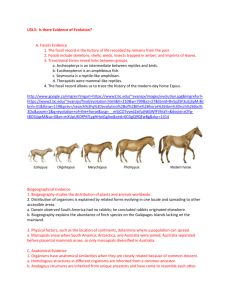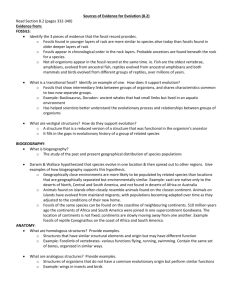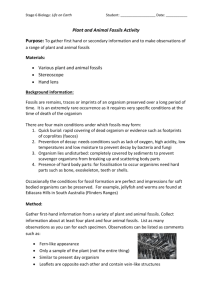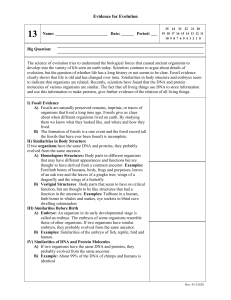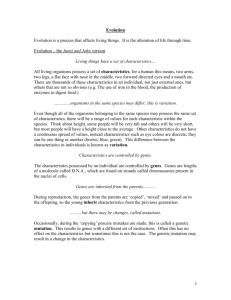File
advertisement
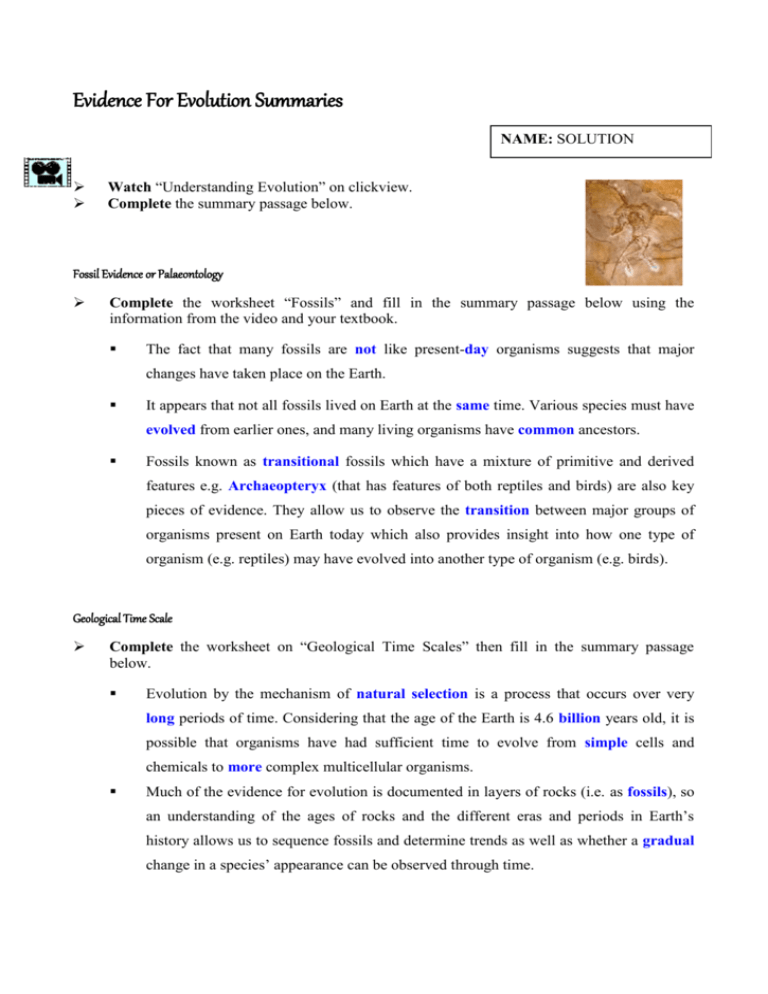
Evidence For Evolution Summaries NAME: SOLUTION Watch “Understanding Evolution” on clickview. Complete the summary passage below. Fossil Evidence or Palaeontology Complete the worksheet “Fossils” and fill in the summary passage below using the information from the video and your textbook. The fact that many fossils are not like present-day organisms suggests that major changes have taken place on the Earth. It appears that not all fossils lived on Earth at the same time. Various species must have evolved from earlier ones, and many living organisms have common ancestors. Fossils known as transitional fossils which have a mixture of primitive and derived features e.g. Archaeopteryx (that has features of both reptiles and birds) are also key pieces of evidence. They allow us to observe the transition between major groups of organisms present on Earth today which also provides insight into how one type of organism (e.g. reptiles) may have evolved into another type of organism (e.g. birds). Geological Time Scale Complete the worksheet on “Geological Time Scales” then fill in the summary passage below. Evolution by the mechanism of natural selection is a process that occurs over very long periods of time. Considering that the age of the Earth is 4.6 billion years old, it is possible that organisms have had sufficient time to evolve from simple cells and chemicals to more complex multicellular organisms. Much of the evidence for evolution is documented in layers of rocks (i.e. as fossils), so an understanding of the ages of rocks and the different eras and periods in Earth’s history allows us to sequence fossils and determine trends as well as whether a gradual change in a species’ appearance can be observed through time. Biogeography or Geographical Distribution Biogeography is the study of the distribution of organisms. For example, marsupials eg. kangaroos and koalas are found mainly in Australia. Fossil marsupials have been found in North America, South America and Australia, but none in Africa or Europe. Scientists have inferred that Australia, Antarctica, South America and Africa were once part of the supercontinent Gondwana. Africa separated from the landmass 100 million years ago before the marsupial evolved. Marsupials evolved and were distributed widely over the remaining land mass before these continents began to separate by continental drift. Each of the continents were then exposed to different climates and only in Australia did many different types of marsupials evolve. Comparing Embryos Collect the comparing embryos activity from your teacher and complete it before filling in the summary below. When the embryos of different vertebrates (eg. chicken, pig, rabbit, human) are studied, similarities can be seen. These similarities suggest that these organisms have evolved from a common ancestor. Comparative Anatomy Collect the comparative anatomy activities from your teacher and complete them before filling in the summary below. This is a study of similarities and differences in body structure and a good example is the pentadactyl limb of vertebrates. This provides evidence that all vertebrates have evolved from a common ancestor but because they have all been exposed to different environments the limb has changed because of natural selection. Comparative DNA or Biochemical Studies Up until the last 30 years or so, most of the studies that show evolutionary links between organisms relied on comparative anatomy (eg. pentadactyl limb), and evidence from fossils and biogeographical distribution. Now, however, the DNA in living species and in fossils can be analysed and compared. Other chemicals such as proteins can also be examined. If there is a close evolutionary link between organisms (eg. humans and chimpanzees) there will be a high % similarity of DNA strands. If two species are not closely related then they will have less similarity in their DNA (eg. a frog and a human would have low % similarity in their DNA than the human and the chimp).

